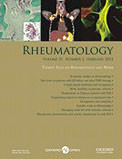Cerezo LA, Kuncová K, Mann H, Tomcík M, Zámecník J, Lukanidin E, Neidhart M, Gay S, Grigorian M, Vencovsky J, Senolt L. Rheumatology (Oxford). 2011 Oct;50(10):1766–72. Epub 2011 Jun 28. IF: 4.171

Department of Pathology and Molecular Medicine
Abstract
OBJECTIVES: The S100A4 protein is known as a metastasis promoting factor; however, its involvement in non-malignant diseases such as RA and psoriasis has been recently described. The aim of this study was to investigate the expression and possible role of S100A4 in idiopathic inflammatory myopathies. METHODS: S100A4 protein expression was detected by immunohistochemistry in muscle tissue from control individuals (n = 11) and patients with PM and DM (n = 8/6). IF staining was used to co-localize S100A4 with selected cells. Cytokine expression and protein synthesis in S100A4-treated cells were analysed by RT-PCR and ELISA. RESULTS: S100A4 protein was significantly up-regulated in muscle tissue of patients with inflammatory myopathies compared with control individuals and was associated particularly with the presence of mononuclear infiltrates. Only few regenerating muscle fibres in PM/DM expressed S100A4. Then we analysed the effect of S100A4 on human myocytes and peripheral blood mononuclear cells (PBMCs). Although S100A4 did not affect myocytes, stimulation of PBMCs with S100A4 significantly induced the expression and synthesis of TNF-α, IL-1β and IL-6, but not of IFN-α. We showed that S100A4 is not directly involved in perforin/granzyme B-induced apoptosis and that it does not modulate the expression of Bax and Bcl2 mRNA in myocytes and PBMCs. CONCLUSION: Increased expression of S100A4 in inflamed muscle tissue highlights its potential role in the pathogenesis of inflammatorymyopathies. S100A4 may act as a cytokine-like factor indirectly promoting muscle fibre damage by stimulating mononuclear cells to increase the synthesis of pro-inflammatory cytokines.
-mk-
